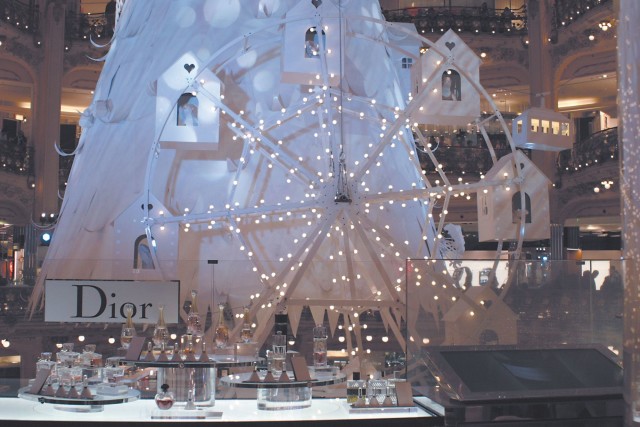With the approach of the Holidays, everyone’s mind turns to festive decorations, new party outfits, special treats and, of course, gifts — in other words, to shopping! The process can be luxurious, exciting, tedious, stressful, or simply practical with a click of a button online. In any case, it is an essential experience of the Holiday season and an important indicator of a country’s economic health. To get an expert opinion on modern retail shopping trends in the world and in Ukraine, The Odessa Review spoke to Nic Wolfs, the managing director of Wolfs Retail Consultants, a company that has advised the development and feasibility of major shopping centers in Holland, Central and Eastern Europe. Mr. Wolfs recently gave a lecture in Odessa on a proprietary system developed for analyzing shopping center performance at a Fryday W: Retail event held at the UNO Design Hotel.
The Odessa Review (Katya Michaels): Mr. Wolfs, based on your experience with retail consulting — what are some world trends in shopping that you find interesting?
Nic Wolfs (NW): As far as I can see, there are a few major trends that are changing the retail landscape. First of all, shopper convenience will determine how retail will develop. Today, people are juggling a lot every day, trying to maintain the proverbial work/life balance. The retail industry must become more responsive to this by expanding services, diversifying, optimizing multichannel availability (online and offline, digital and physical) and transport convenience.
Secondly, shopping environments will have a purpose organized around a specific human need, like a holistic environment empowering people’s health and bringing the community together. Also, new retail concepts will bring attention to the story behind the product or brand — to its heritage and sustainability, where it comes from, its purpose, the history of the maker.
OR: In the past two or three years, what are the major retail changes that have affected consumers in Central and Eastern Europe, in Ukraine?
NW: While I have years of experience in the development of shopping centers in Central Europe, this is just my second visit to Ukraine. However, I can already see that consumer needs and spending patterns are quite comparable. From the moment the Ukrainian markets were open, international retail chains and developers of shopping centers made their appearance — in a sequential way. Starting with a focus on basic necessities (Metro, Auchan), next the improvement of the residential environment (Leroy Merlin, Jysk), and then followed by specialty stores like Zara, Vodaphone, Douglas. In countries like Ukraine, the consumers’ interest in these retail developments is initially greater than their purchasing power, which means that the ingrowth time is longer than in Western countries. Obviously, this is related to the increase of income and employment as well as the overall economical and political perspectives.
OR: What role does technology play in shopping today? Does Ukraine differ from Western Europe in this respect?
NW: Certainly, consumer interest in IT communication, research and shopping is global, but the extent to which these resources are used is highly dependent on the stage of development of the country. About 50% of the Ukrainian population above 16 years of age are active users of the internet. Based on a GfK report, almost 3 million Ukrainians are online consumers. Admittedly, most Central European countries show a higher score. No doubt that strong retail growth will also soon take place in Ukraine and interest in online shopping and mobile shopping apps will increase.
Online shopping is very convenient, but I don’t believe that storefront shopping will ever die out. In fact online companies like Amazon are now creating brick and mortar stores, expanding offline. Physical shopping will always stay very important, especially with things that are connected to emotions and tactile experiences like fashion, cosmetics.
OR: In the United States, early Christmas shopping and Black Friday deals are major retail phenomena — do you think this trend is becoming more popular in Ukraine as well?
NW: Even though some practices are adapted internationally, like Halloween, generally I think that countries maintain their own purchase patterns based around their traditions and religious holidays. In Ukraine, Christmas is after the New Year, which is the opposite of Western Europe and America — this influences the way people shop.
A growing trend in holiday shopping is giving unique gifts — people want their presents to be unexpected and personal. In fact, personalization is becoming more important in all aspects of retail, and technology will make it possible. For example, there will be only one size of dress displayed in the store so you can feel the fabric and see the color, but then a computer in the fitting room calculates your size perfectly and shows you in the mirror exactly how you will look in the dress.
OR: Does your research in shopping center construction and feasibility indicate that there are specific preferences or challenges in Eastern Europe and Ukraine specifically?
NW: The conditions that shopping centers must meet in the technical sense are universal: accessibility for all forms of transport, spatial considerations, security, internal and external logistics, climate and sustainability. Architecturally, the stores must be designed to make the merchandise, and not the construction elements, the message. Of course, it’s important to have a good understanding of target groups and potential clients to inform the right mix of stores, restaurants and entertainment.
In some modern retail spaces, these principles are not well implemented. Customers in Ukraine are very eager to visit shopping centers, but often the malls are not well adapted to their expectations. Sometimes, the stores are too expensive, leading to a negative impression instead of a positive one. It is wiser to start a mall being less luxurious, feasible for a wider audience, and make adjustments in the future based on changing consumer needs and habits.
A really good shopping center will have the right balance between well-known international chains and local entrepreneurs who can support the national feeling, which is so important in Ukraine right now. Local producers can stay competitive through offering a special kind of service and experience. The millennials are willing to pay a premium for a product that supports a certain world view, has a certain back story and adds value to their life. This is a major trend now, even in Ukraine where the standard of living is not as high yet. Surely Ukraine is in a difficult period right now, people don’t know what’s going to happen, but I am sure it will improve, I am not negative at all. You should not underestimate the future development of Ukraine!
Katya Michaels is Senior Editor of The Odessa Review.
Citations: No doubt that strong retail growth will also soon take place in Ukraine and interest in online shopping and mobile shopping apps will increase




































